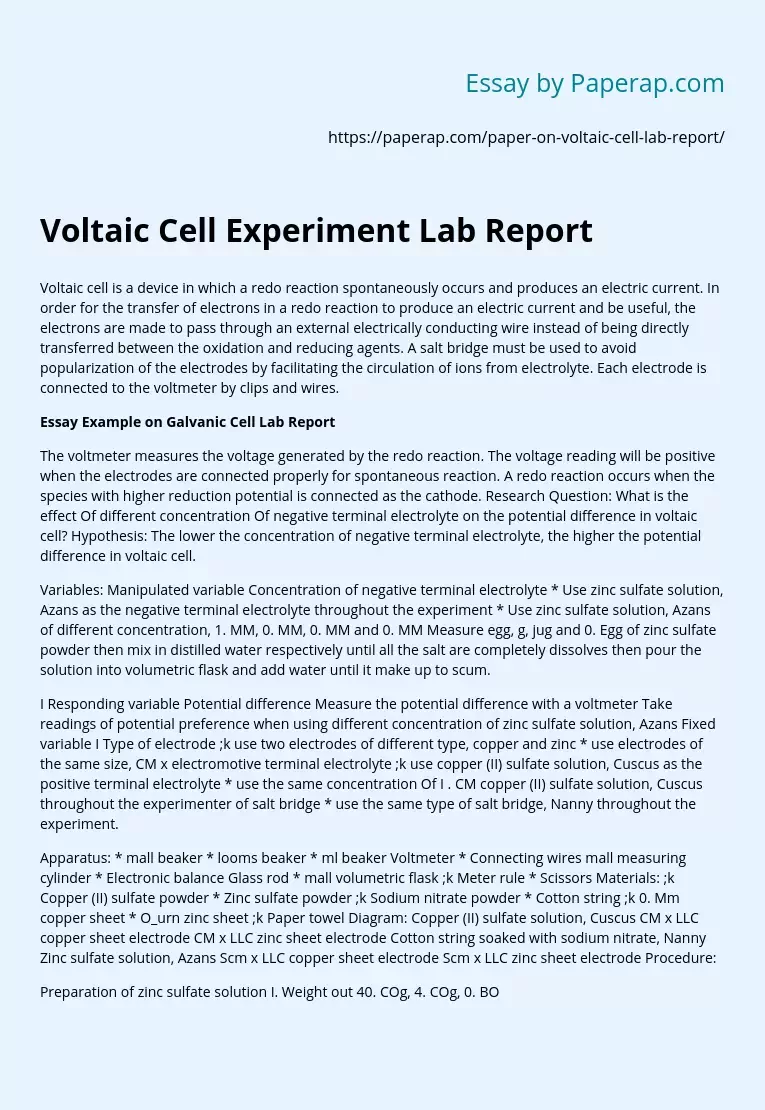Voltaic Cell Experiment Lab Report
Voltaic cell is a device in which a redo reaction spontaneously occurs and produces an electric current. In order for the transfer of electrons in a redo reaction to produce an electric current and be useful, the electrons are made to pass through an external electrically conducting wire instead of being directly transferred between the oxidation and reducing agents. A salt bridge must be used to avoid popularization of the electrodes by facilitating the circulation of ions from electrolyte. Each electrode is connected to the voltmeter by clips and wires.
Essay Example on Galvanic Cell Lab Report
The voltmeter measures the voltage generated by the redo reaction. The voltage reading will be positive when the electrodes are connected properly for spontaneous reaction. A redo reaction occurs when the species with higher reduction potential is connected as the cathode. Research Question: What is the effect Of different concentration Of negative terminal electrolyte on the potential difference in voltaic cell? Hypothesis: The lower the concentration of negative terminal electrolyte, the higher the potential difference in voltaic cell.
Variables: Manipulated variable Concentration of negative terminal electrolyte * Use zinc sulfate solution, Azans as the negative terminal electrolyte throughout the experiment * Use zinc sulfate solution, Azans of different concentration, 1. MM, 0. MM, 0. MM and 0. MM Measure egg, g, jug and 0. Egg of zinc sulfate powder then mix in distilled water respectively until all the salt are completely dissolves then pour the solution into volumetric flask and add water until it make up to scum.
I Responding variable Potential difference Measure the potential difference with a voltmeter Take readings of potential preference when using different concentration of zinc sulfate solution, Azans Fixed variable I Type of electrode ;k use two electrodes of different type, copper and zinc * use electrodes of the same size, CM x electromotive terminal electrolyte ;k use copper (II) sulfate solution, Cuscus as the positive terminal electrolyte * use the same concentration Of I .
CM copper (II) sulfate solution, Cuscus throughout the experimenter of salt bridge * use the same type of salt bridge, Nanny throughout the experiment.
Apparatus: * mall beaker * looms beaker * ml beaker Voltmeter * Connecting wires mall measuring cylinder * Electronic balance Glass rod * mall volumetric flask ;k Meter rule * Scissors Materials: ;k Copper (II) sulfate powder * Zinc sulfate powder ;k Sodium nitrate powder * Cotton string ;k 0. Mm copper sheet * O_urn zinc sheet ;k Paper towel Diagram: Copper (II) sulfate solution, Cuscus CM x LLC copper sheet electrode CM x LLC zinc sheet electrode Cotton string soaked with sodium nitrate, Nanny Zinc sulfate solution, Azans Scm x LLC copper sheet electrode Scm x LLC zinc sheet electrode Procedure:
Preparation of zinc sulfate solution I. Weight out 40. COg, 4. COg, 0. BOB and 0. 048 of zinc sulfate powder then dissolve the powder into distilled water in ml beaker respectively. 2. Pour the zinc sulfate solution into Simi volumetric flask separately and label it. 3. Add distilled water into each volumetric flask until it makes up to mall. 4. Mix the solution well in each volumetric flask. Preparation Of salt bridge 5. Weight out egg of sodium nitrate powder then dissolves the powder into distilled water in Some beaker.
Voltaic Cell Experiment Lab Report. (2019, Nov 27). Retrieved from https://paperap.com/paper-on-voltaic-cell-lab-report/

